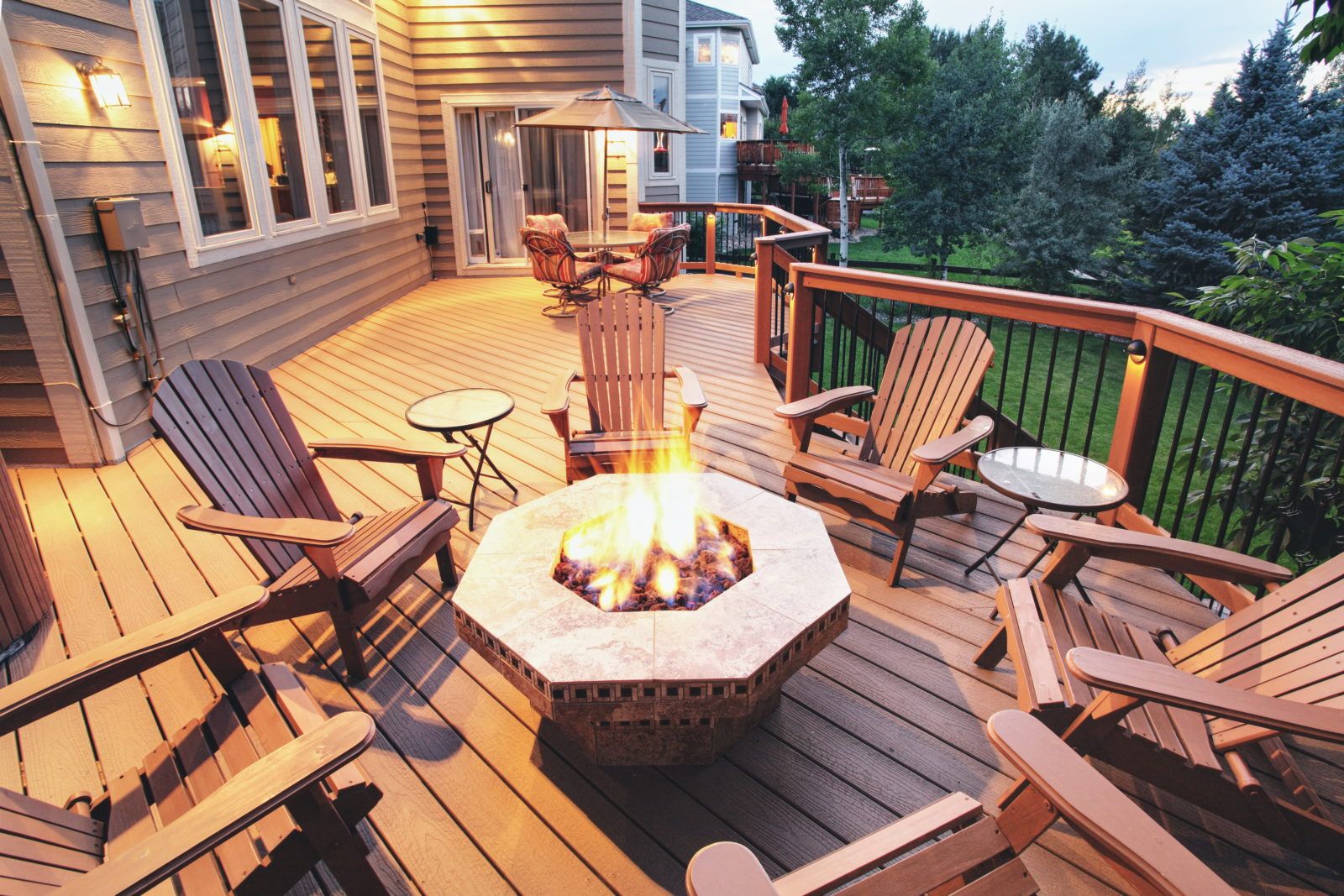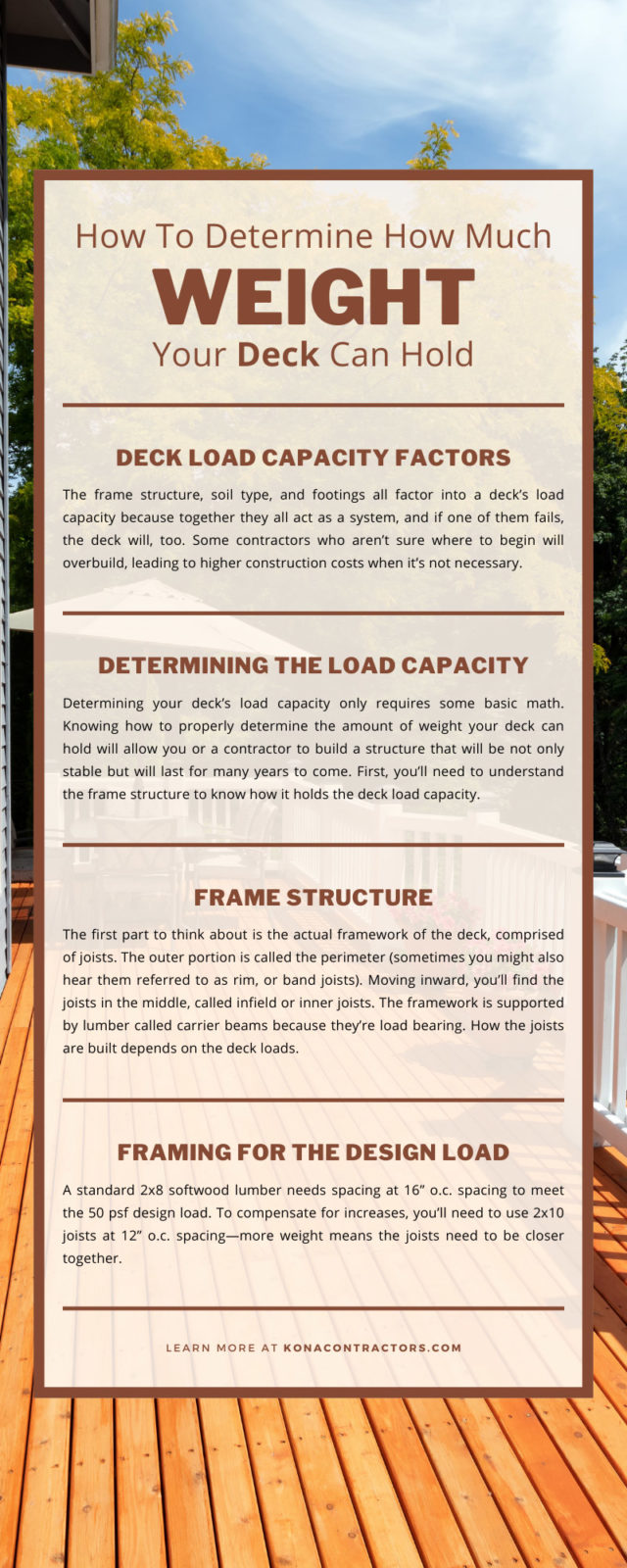
How To Determine How Much Weight Your Deck Can Hold
The design of a deck doesn’t only consider the style and material. It also considers how much weight you’ll need the deck to hold to accommodate not only people, but furniture and other factors that have substantial weight, like fireplaces or hot tubs.
Ideally, you’ll want to have those factors determined before construction, but if you have an existing deck and want to add features, there are ways to find out your deck’s load capacity by analyzing the frame structure, soil, and footings.
Learn how to determine how much weight your deck can hold so you can add all the elements you’d like in your outdoor space. But beware: there will be math involved!
Deck Load Capacity Factors
The frame structure, soil type, and footings all factor into a deck’s load capacity because together they all act as a system, and if one of them fails, the deck will, too. Some contractors who aren’t sure where to begin will overbuild, leading to higher construction costs when it’s not necessary.
Even if you build a strong deck, it’ll gradually sink into the soil if the contractors don’t build the correct size of footings to compensate for the deck’s load. And once the deck begins to sink, it can rip the ledger board away from your home, leaving your deck free-floating and unstable. To correct it, you or a contractor will need to raise up the sunken part to pour new footings.
Determining the Load Capacity
Determining your deck’s load capacity only requires some basic math. Knowing how to properly determine the amount of weight your deck can hold will allow you or a contractor to build a structure that will be not only stable but will last for many years to come. First, you’ll need to understand the frame structure to know how it holds the deck load capacity.
Frame Structure
The first part to think about is the actual framework of the deck, comprised of joists. The outer portion is called the perimeter (sometimes you might also hear them referred to as rim, or band joists). Moving inward, you’ll find the joists in the middle, called infield or inner joists. The framework is supported by lumber called carrier beams because they’re load bearing. How the joists are built depends on the deck loads.
What Are the Different Deck Loads?
There are different loads that engineers or contractors need to account for when building any structures, including decks.
Design Load
This is the starting point for what a floor deck can support and are from actual code requirements for the floors of residential homes. When a contractor, or yourself, is building a deck, it should be as strong as the floor inside your house.
Builders measure design load, also called the total load, in pounds-per-square-foot (psf). But design load has two parts: the dead load and the live load.
Dead Load
Dead load is the load of the deck itself. Typically, this accounts for 10 psf.
Live Load
A live load is all the extras on the deck, like people, furniture, and plants, and is usually around 40 psf. Altogether, a deck’s design load is generally 50 psf. But the live load will change depending on whether you add bulky items, like a hot tub or a fireplace, and even the weather.
Snow Load
But what if you live in an area that experiences heavy snowfall every winter, like Denver? If you live in a region that experiences significant winter weather, or if you want to add that hot tub, the live load of your deck will obviously increase, and it could even double. So, how do you account for these differences in loads?
Framing for the Design Load
A standard 2×8 softwood lumber needs spacing at 16” o.c. spacing to meet the 50 psf design load. To compensate for increases, you’ll need to use 2×10 joists at 12” o.c. spacing—more weight means the joists need to be closer together.
Next, you’ll have to figure out the tributary areas of your deck to get the total load.
Tributary Areas and Footings
To find out the maximum weight your deck can hold, you’ll need to multiply the total area by 50 psf. For example, a 100 square foot deck can support 5000 pounds. Again, this is an estimate that engineers have decided is a safe value for a deck accounting for the typical items a deck would hold. The tributary area affects how the weight is displaced onto the footings below.
Depending on the framework and size of your deck, you’ll need to do further calculations to find the exact weight your deck can safely hold, by calculating the four tributary areas of your deck. For example, one area is from the ledger board to the carrier beam and another is from the beam to the end of the deck. All four areas require slightly different configurations.
Footing Sizes
After you’ve discovered the tributary areas, you’ll need to determine the footing sizes. You can reduce the force imposed over any given area by using a larger footing size and distributing that weight over an area. For example, a one square-foot footing would have 1000 pounds of weight to bear, whereas a two square-foot footing would only be supporting 500 square-feet.
Weight on the Soil
The type of soil determines how heavy the load can be before the footings begin to settle. You’ll need to divide the weight by the size of the footing. Organic soils are not ideal, and you’ll need to replace soil or clay with stone or gravel to create a strong base. Once you have the proper aggregate in place, you can build your deck with confidence.
Find an Outdoor Living Contractor
Are you thinking of building a new deck for your home? Instead of learning how to determine how much weight your deck can hold, find an outdoor living contractor to build a deck for you! Kona Contractors are deck-building professionals in Denver that understand the importance of creating a long-lasting and durable deck for you to enjoy.
We’ll help you design the deck you’ve always wanted with the correct load capacity so you can add amenities like a fireplace or a pergola. Learn more about our deck design services by exploring our blogs or contact us to get an estimate!

